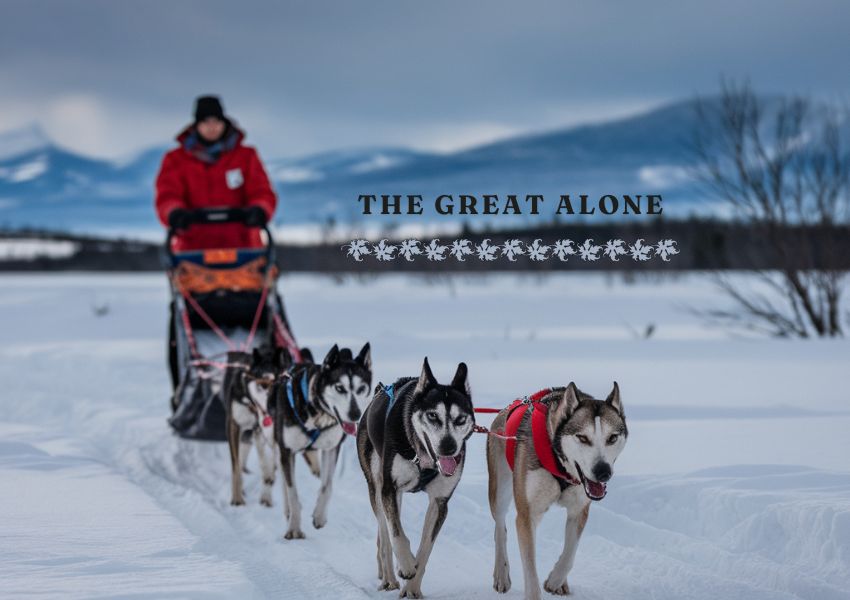The Great Alone, a novel by bestselling author Kristin Hannah, takes readers deep into the Alaskan wilderness, where a family faces the challenges of isolation, survival, and their inner demons. Set in the 1970s, this heart-wrenching and evocative story follows Leni Allbright, a teenage girl thrust into a world of brutal winters, endless darkness, and a fractured family dynamic. Through her story, Kristin Hannah reveals the power of human resilience and the relentless grip of love and loyalty, even in the face of overwhelming hardship.
Introduction
Kristin Hannah has built a reputation for crafting emotionally rich, character-driven stories that explore the complexities of human relationships, resilience, and transformation. Known for novels like The Nightingale and Firefly Lane, Hannah has captivated readers with her immersive storytelling style and unforgettable characters. The Great Alone continues this tradition, plunging readers into the untamed beauty of Alaska while exploring the raw, emotional journey of a family struggling to survive not only the wilderness but also the complexities within their own hearts.
Synopsis of The Great Alone
The Great Alone begins with Ernt Allbright, a Vietnam War veteran haunted by the traumas of war. His struggles with PTSD and anger lead him and his family—his wife, Cora, and their daughter, Leni—to Alaska, where he hopes to find solace and a fresh start. Drawn by the promise of independence and the pristine beauty of Alaska, the Allbrights move to a small, isolated cabin. However, as they confront the unforgiving challenges of the Alaskan wilderness, the family’s already fragile bonds are tested to their limits.
Leni, who comes of age in this raw and unpredictable environment, becomes the lens through which readers experience Alaska’s beauty and danger. Her growing awareness of her father’s instability and her mother’s resilience drives much of the narrative, illuminating the themes of survival, love, and loyalty.
Themes in The Great Alone
Survival and the Alaskan Wilderness
One of the novel’s central themes is survival, both in the physical sense and the emotional. The Alaskan wilderness plays a dual role as both a place of incredible beauty and an unpredictable force of nature that constantly tests the family’s endurance. Hannah’s descriptions of Alaska are vivid and immersive, capturing the breathtaking landscapes alongside the perils of long, dark winters, unyielding cold, and isolation. This harsh environment becomes a metaphor for the struggles the family endures within themselves, emphasizing the toll of survival on their mental and emotional well-being.
PTSD and Mental Health
The Great Alone sensitively explores the effects of post-traumatic stress disorder (PTSD), particularly through Ernt Allbright’s character. A Vietnam War veteran, Ernt struggles with rage, nightmares, and paranoia that shape his interactions with his family. His PTSD and its impacts on his relationships highlight the often-overlooked challenges that veterans face when they return from war. Kristin Hannah tackles this topic with empathy, illustrating the devastating toll it can take not only on those suffering but also on their loved ones.
Love, Loyalty, and Family Bonds
Leni’s relationship with her parents, particularly with her mother, Cora, forms the emotional core of the story. Despite her father’s volatility, Leni feels a strong sense of loyalty to her family, especially her mother, who faces her struggles with courage and resilience. Cora’s love for Ernt, despite his flaws and abusive behaviour, captures the complexity of loyalty and the bonds that tie people together. Leni’s loyalty is also tested by her budding friendship and eventual romance with a local boy, Matthew Walker, as she grapples with the conflict between her family obligations and her desire for happiness.
Coming of Age and Personal Growth
Leni’s journey is one of self-discovery and growth, as she learns to navigate the harsh realities of her surroundings and her family’s turbulent dynamics. As she matures, Leni’s understanding of love, survival, and courage deepens, shaping her into a strong and resilient young woman. The challenges she faces—from the brutal Alaskan winters to the emotional turmoil within her family—force her to confront her own identity and aspirations, ultimately guiding her toward a future shaped by both the traumas she has endured and the strength she has gained.
Character Analysis
Leni Allbright
Leni is a compelling protagonist whose journey reflects both vulnerability and strength. As she comes of age in Alaska, she grows from a young girl into a resilient, courageous woman. Her empathy and loyalty drive her decisions, yet she learns to balance. They with self-preservation and a desire for happiness. Leni’s character captures the challenges of growing up under difficult circumstances. And her journey resonates with readers who see her struggles and triumphs as reflections of their own.
Ernt Allbright
Ernt is a tragic figure, shaped by his traumatic experiences in Vietnam and the mental health challenges that follow. His love for his family is evident, yet his PTSD and paranoia push him to a volatile edge, isolating him from his loved ones. Ernt’s character serves as a stark reminder of the long-lasting impact of war on individuals and families. Showing how untreated mental health issues can transform even the closest bonds into sources of pain.
Cora Allbright
Cora, Leni’s mother, embodies both strength and vulnerability. She endures Ernt’s instability with a mixture of love, loyalty, and fear. Torn between her commitment to her husband and her responsibility to protect her daughter. Cora’s resilience shines through as she navigates her complex emotions, ultimately demonstrating the sacrifices and courage required. Of those who love someone suffering from mental illness.
Significance of The Great Alone’s Setting in Alaska
Alaska is not just the backdrop of The Great Alone; it’s a character in its own right. The unforgiving beauty of the Alaskan wilderness shapes every aspect of the Allbrights’ lives. From their daily routines to their survival strategies. Alaska’s vastness and isolation amplify the tension within the family, providing both a refuge and a prison. For Leni, Alaska is a place of discovery and transformation, as she finds strength and independence amid the challenges of her environment.
The Role of Community in The Great Alone
In the remote Alaskan town where the Allbrights settle, the tight-knit community plays. A vital role in supporting one another through Alaska’s challenges. The locals’ generosity and resilience reflect the spirit of survival, as they share resources. Offer companionship, and stand together during crises. Characters like Large Marge and the Walkers become extended family to Leni. Providing a support network that contrasts with her turbulent family life.
Life Lessons from The Great Alone
The Great Alone imparts several powerful life lessons:
- Resilience in the Face of Adversity: Leni’s journey underscores the importance of resilience and adaptation when facing life’s challenges, whether external or internal.
- The Complexity of Love and Loyalty: The novel highlights how love can be both uplifting and destructive, showing that loyalty sometimes requires painful choices for one’s own well-being.
- Appreciation for Nature: Hannah’s portrayal of Alaska reminds readers of nature’s power, beauty, and unpredictability, urging a deeper appreciation for the natural world.
- The Importance of Community: The tight-knit Alaskan community illustrates the strength that comes from mutual support and collective survival, emphasizing the value of connection even in the most isolated places.
Why The Great Alone Resonates with Readers
Readers are drawn to The Great Alone for its deeply human portrayal of family dynamics, survival, and personal growth. Kristin Hannah’s empathetic storytelling and nuanced characters allow readers to see their struggles and strengths reflected in Leni’s journey. The novel’s exploration of mental health, resilience, and self-discovery resonates with those who have faced their challenges. Creating a powerful narrative that leaves a lasting impact.
Frequently Asked Questions
What is The Great Alone about?
The novel follows the Allbright family as they move to Alaska to start anew. Facing the challenges of wilderness survival and the complexities of family dynamics and mental health struggles.
What are the main themes of The Great Alone?
The primary themes include survival, PTSD, family loyalty, resilience, and the impact of isolation on mental health and relationships.
How does The Great Alone end?
Without revealing too much, the story concludes with Leni finding her own path, shaped by her experiences and her resilience in overcoming her family’s challenges.
Why is Alaska a significant setting in The Great Alone?
Alaska’s harsh, isolated landscape amplifies the novel’s themes of survival and resilience, serving as both a source of beauty and danger for the characters.
Is The Great Alone based on a true story?
While the characters and story are fictional, Kristin Hannah drew inspiration from her personal experiences and historical research on Alaska during the 1970s.
What does The Great Alone teach about resilience?
The novel demonstrates resilience through Leni’s ability to navigate family trauma, adapt to Alaska’s harsh conditions, and grow into a strong, self-reliant individual.
Conclusion
The Great Alone by Kristin Hannah is a powerful story of family. Survival and self-discovery are set against the breathtaking and brutal backdrop of Alaska. Through Leni Allbright’s journey, readers experience a range of human emotions, from love and loyalty to fear and resilience. Hannah’s masterful storytelling captures both the beauty and danger of Alaska while exploring the complexities of family and mental health. This unforgettable novel resonates deeply, reminding readers of the strength within themselves to face life’s most daunting challenges.











